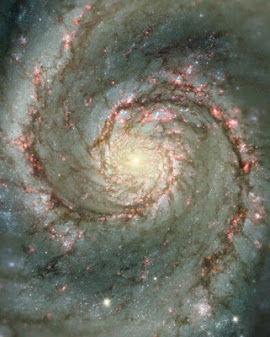Density wave formed spiral galaxy
Interestingly, the use of density wave model development is largely contingent on the Boltzmann equation which is also used in space plasma physics. Thus:
¶f/ ¶t + v grad f + F/m ¶f/¶t = (¶f/¶t)C
where the ¶f/ ¶t are partial derivatives, and (¶f/¶t)C
is the time rate of change in f (the velocity distribution function) due to collisions, i.e. between masses within the system. Technically, the Boltzmann eqn. is applied to FLUIDS and for that purpose the galaxies to which density wave approaches or models are applied are modeled firstly in the fluid format. (It is easier when dealing with an agglomeration of some 100 or 200 billion separate stars and associated orbits to think of them as comprising a "fluid" as opposed to say, 100 billion separate bodies to be treated in a 100 billion -body problem of celestial mechanics!)
We see from this that the question as to why the spiral pattern is not affected by stars much further out cannot really be properly answered unless a full vetting of the assumed density waves for the particular galaxy is presented. In this sense, one recognizes that a full analysis of density waves for a galaxy - call it "Barred G1"- is needed before one can say stars in a given G1 region (e.g. inner or outer) "move faster or more slowly" than the waves at that place. We need to know then: the physical conditions for the establishment of the density waves at location r1 in G1 and r10 in G1 where the r's denote radial distances from the center with r10 = 10 (r1).
Another problem in dealing with density wave models is the fact they are mainly based on the mode chosen for particular dynamical wave equations that can be applied to the fluid framework. (Note: A "mode" is a standing wave that can be supported by a disk of given dimensions, mass.) More broadly, most astronomers who work in this narrow specialist area use the term interchangeably with Fourier m-component. (And it should be understood here that one of the main tools is Fourier analysis of the waves, but alas Fourier analysis is only taught usually to those who take advanced Calculus or analysis courses).
As an example, a particular Fourier coefficient, call it an, applicable to a wave - may be defined:
an = 1/π ò -π π f(x) cos mx dx
where m is the Fourier m-component.
What types of modes can one have in these models? One is the "global" or m= 1 mode. Then there are the unstable (m= 2) modes.
Whether one mode or another appears (or is used in a spiral galaxy modeling) is critical since it may well determine at what stage a barred spiral develops, if at all. Alas, another complexity enters here since mode analysis is not simply a stand alone but also incorporates a subtle aspect called "marginal stability analysis" wherein one will solve for a quantity Q and if it is very close to 1 one has the case of marginal stability and tightly wound modes or in the case of spirals, around the Sa class. The trouble is that when one seriously incorporates any heating of the disk for whatever reason (say a massive central black hole sucking up matter and generating much radiation) then the desired values of Q are soon out of range, making it impossible for a given spiral structure to sustain itself.
Lastly, whenever one considers density waves in galaxies, it's important to bear in mind there remain enormous stumbling blocks even when applied to the simplest models of galactic disks (e.g. "zero thickness" disks). One of these arises from potential theory. Thus, the perturbed gravitational field at one location depends on the density perturbation at every other location. How will you know, ab initio, that the density perturbation at location r, φ, z say, does not accelerate the associated wave (in the fluid rest frame) to a higher velocity than any stars at the same or near location? You don't unless you investigate!
Still, an amazing number of relatively simple problems pertaining to spiral galaxies can be solved using just basic information. One such problem is given below for the interested (and industrious) reader to work out:
Problem:
The number c of epicycle oscillations per orbit about a galactic center, is given by the ratio of the star’s epicycle frequency (ko) to its orbital angular speed, W.
Or: c = ko / W
a) Compute W for the Sun given that the Sun’s period around the galactic center is: 2 x 10 8 yrs.b) Then find the Sun’s epicycle frequency (ko) if we know c = 1.35. (Note: if
the ratio c is integral, or a
non-decimal number, we say the orbit is “closed”. If non-integral it
is not closed). Because of differential rotation rates and the local angular
velocity (W L) differing
from the inertial value, the solar region is open.
c)
Compute the local angular velocity (W L) for the Sun if:
m(W -
W L) = n ko where m = 2 and n = 1
See Also:
Selected Questions - Answers From All Experts Astronomy Forum (Spiral Galaxy Shape)
And:
Is This The Most Distant Galaxy - Or Is The Freakish (Z-Shift) Object HD1 Something Else?
And:
ESA's "Gaia" Telescope Reveals Bounty Of Data On Our Galaxy (brane-space.blogspot.com)
And:

No comments:
Post a Comment